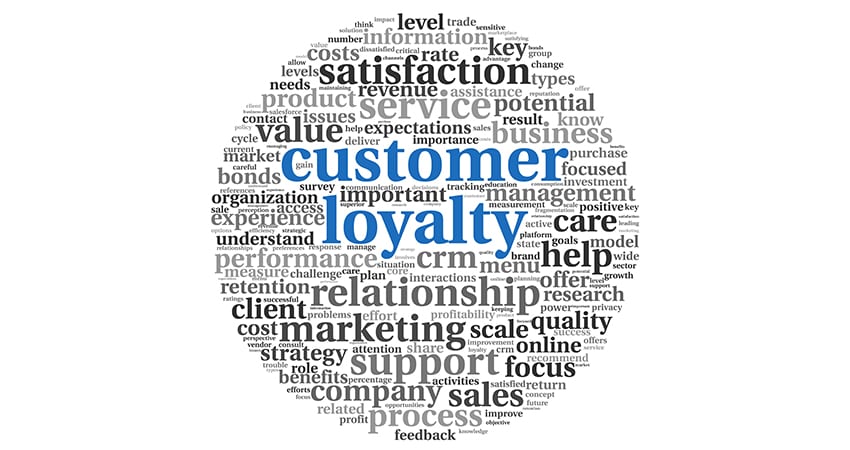Business is besieged with metrics. Return on Investment (ROI), website visits, website return visits, shopping cart abandonment rates, and average customer spend are all important, but customer loyalty might be the best metric to evaluate the success of a business. As with all business problems, everyone agrees that metrics are vitally important. What no one can agree on is which metrics are the most important. Until now.
The most important marketing metric is customer loyalty. Customer loyalty is the ongoing instance of a customer that continues to repurchase from a business when they have competitor and substitute offers available. Every morning you go to the same coffee shop which is slightly out of your way when there are several other coffee shops closer to your route. You pass by a tea shop and a doughnut shop, so you can get your same small coffee day after day. On most Friday’s, you treat yourself to a scone.
On an individual customer basis, the one customer that buys one item a day is practically invisible. Yet, it is the collection of loyal customers that are at a business every day and purchase every instance when they have a need that are the most valuable to a business. This collection of loyal customers is what sustains a business, allows it to grow, allows it to outlast competitors, and allows it to innovate and create new products and services. Customer loyalty works well in Business-2-Consumer (B2C), Business-2-Business (B2B), and in every industry. Customer loyalty is your number one success metric to maintain and to grow.
How Many Loyal Customers Do You Have
The first step in growing customer loyalty is to determine what percentage of your customers and what percentage of your revenue comes from loyal customers. You may be able to use data from existing loyalty programs, credit card information, or other data sources to determine the number of loyal customers. Most importantly, your organization, from a small coffeeshop to a multi-billion international enterprise, must agree on a definition of a loyal customer. Loyalty could be weekly for a restaurant or gas station or it could be once every three months for an auto dealer service department. The central issue is to have a proven definition of what loyalty is for every employee.
Use A Net Promoter Survey (NPS) Of Your Customers
What keeps the loyal customers loyal? The Net Promoter Process (NPS) is one of the simplest and most telling tools of evaluating customer loyalty and helping a business grow loyal customers. The NPS is based upon the question, “Would you recommend this product or service?” The customer can then respond based on a low score (number = 0) or a high score (number = 10) scale. Only a score of a 9 or a 10 makes a customer a Promoter. Customers that have scores from 0 to 6 are Detractors, most likely un-loyal customers. When you subtract the Detractors from the Promoters, you have a Net Promoter Score. NPS surveys should also tell you what Promoters like and what Detractors want to see improved.
Innovate & Test to Meet Emerging Loyal Customer Needs
Business results, survey results, industry trends, customer focus groups, and employee ideas are the dataset for creating and innovating ideas to grow more loyal customers and to maintain existing loyal customers. Once you have ideas then start performing small tests to see how your ideas grow loyal customers. Vital to these tests are to have a separate group for evaluation that are not involved in the pilot. These “control groups” are essential to ensure that your test results are directly attributable to your new ideas and not the result of another unintended consequences. Forget long and in-depth product development cycles. Instead, innovate, test, and implement fast.
Watch & Respect Your Competitors
As you grow loyal customers, your competitors will be watching, innovating, and acting themselves. The first tool of desperate and motivated competitor is often price decreases, a danger in any business or industry. Think about how to use loyalty programs, special events, unique products, and meaningful rewards to maintain and grow loyalty in the face of competitor activity. When you respect a competitor, you analyze, anticipate, and design around a competitor offering instead of dismissing the competitor with a wave of the hand. Businesses that care about customer loyalty respect their competitors.
Adopt a Leadership Style of Humility with A Passion for Customer Experience
The most important aspect of growing customer loyalty is a leadership style that combines humility with a passion for great customer experience. A leadership style of humility represents that you never take customer loyalty for granted. A passion for Customer Experience recognizes that customer loyalty is and always will be an ongoing initiative and never completed. When leadership humility and a passion for Customer Experience come together you get a team that is driven, motivated, and passionate for meeting customer and business needs together.
Customer loyalty is how businesses succeed over the long term. A business and customer relationship that is based on humility, respect, innovation, great customer experience, and solid products and services is great for both the business and the customer. Finally, and most importantly, growing customer loyalty is a journey and never a destination so the businesses passion to perform and to improve must be non-stop.
Chad Storlie is a published author


Fred Reichheld who developed NPS, explained in his book, “The Loyalty Effect”, that customer loyalty and employee loyalty are directly linked. If you are interested in engagement and profitable growth, I suggest looking at companies who excel at both. Industry leaders, like Southwest Airlines, Capital One and BHP Billiton, and hundreds of private companies empower employees to think and act like owners, driving and participating in the profitable growth of the company. Their engagement and business results speak for themselves. These Forbes and Harvard Business Review articles provide more background: https://hbr.org/2018/01/more-than-a-paycheck
http://www.forbes.com/sites/fotschcase/2016/05/31/engage-your-employees-in-making-money/